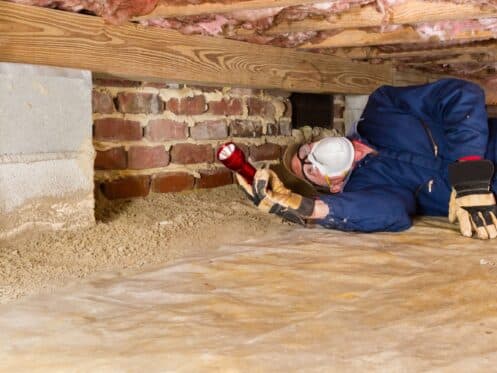The crawl space is too often overlooked by homeowners when it comes to maintenance. Though it’s easy to forget your crawl space when attending to your list of home renovation projects, failing to properly care for and encapsulate your crawl space can create challenges.
The crawl space is one of the more vulnerable areas in your home, as it is very susceptible to leaks, water seepage, and animal infestation. Moreover, poorly cared-for crawl spaces can significantly affect your home’s air quality. Ultimately, a compromised crawl space can spell trouble for your home and its foundation.
When it comes to encapsulating your crawl space, it’s crucial to engage professionals with the right expertise to start the waterproofing process. An expert HVAC technician with specialized knowledge and skills will follow effective waterproofing measures and address any related HVAC issues simultaneously. This way, your HVAC expert can assess your needs for crawl space waterproofing and help you ensure your home is well-maintained from the ground up.
Potential Problems With Crawl Spaces
New homeowners may feel as though waterproofing their crawl space is an unnecessary step. While the crawl space is typically out of sight and out of mind, it’s essential to consider how this space affects the health of your home and family. An abandoned crawl space can quickly result in major problems with wood rot, mildew, and air quality issues.
As a homeowner, keep an eye out for the following common issues that indicate it’s time for you to waterproof your crawl space:
Mold and Mildew Growth
It’s easy for excess moisture to seep into the crawl space. The added moisture is the perfect environment for mildew and mold to thrive. These fungi will spread, releasing spores into the air. If left untreated, this moldy situation can trigger allergies and respiratory issues for you or your family.
Wood Rot
Without adequate waterproofing, your crawl space may experience wood rot. This condition occurs when wooden structural components like floor joists, subflooring, and beams begin to rot from the excess moisture. This will compromise the strength and stability of the crawl space, potentially leading to structural damage and sagging floors.
Increased Humidity Levels
If there is water in your crawl space, this can lead to increased humidity levels in the house. With more humidity in the home, you’re likely to encounter more mold and increased condensation in walls and windows.
Poor Indoor Air Quality
Stagnant water in the crawl space can cause odors and dangerous airborne spores to waft out into your living space. Experts estimate that approximately 50% of the indoor air in the home comes from the crawl space. These contaminants may then circulate throughout the home, negatively affecting your air quality.
Increased Energy Costs
Excess moisture in your crawl space can make it difficult for your HVAC system to regulate the temperature in the home. This situation can lead to higher energy consumption and an increase in utility costs. Alternatively, studies show that crawl space encapsulation can reduce energy bills by up to 20%.
Foundation Issues
Even though the crawl space is a small part of the home, it plays a big role in the health of your foundation. If water seeps into this part of your home, it can cause the soil around it to expand and contract, ultimately resulting in structural issues like a cracked foundation.
How HVAC Experts Encapsulate a Crawl Space
Taking steps to waterproof your crawl space is the best way to protect your home’s future from the threats of mold, structural damage, and low air quality. As you research your options for waterproofing your home’s crawl space, reach out to an expert HVAC technician to help you throughout the process.
In waterproofing your crawl space, your HVAC tech will begin with an inspection and assessment. This inspection allows the expert to identify any existing issues or sources of water intrusion into the crawl space. The technician will look for evidence of moisture, pest infestation, leaks, or mold while inspecting the condition of the walls, insulation, floor, and foundation.
Next, technicians will look for water sources to determine how moisture is leaking into the space. During this process, they will look for plumbing leaks, repair gutters, and downspouts, and fix any surface drainage around your home’s foundation. This way, you’ll be sure that water is kept away from the crawl space, preventing additional water intrusion. The next step in waterproofing the crawl space is to clear away debris, pests, or mold. Oftentimes, crawl spaces contain old building materials like insulation, wood, or concrete that need to be removed as well. The surface area should be clear and clean to begin the waterproofing process.
As HVAC technicians begin to waterproof the space, they’ll install a vapor barrier. This barrier is an essential part of sealing off your crawl space as it will prevent moisture from entering the space from the ground. This process requires a heavy-duty plastic or similar vapor barrier material that covers the floor and walls of your crawl space to seal the seams and securely create an airtight barrier.
Do You Need to Waterproof Your Crawl Space?
Many homeowners believe they are immune to the effects of an unencapsulated crawl space. However, a seemingly dormant problem can quickly turn into a major emergency down the road. Homeowners hoping to steer clear of the effects of a mismanaged crawl space should take action to waterproof this area sooner than later.
Mold and mildew can quickly spread like wildfire in your home, but taking early action with the first signs of excessive humidity and moisture can keep mold spores away for good. Statistics show that if humidity levels stay below 50%, there is insufficient moisture in the air for mold to reproduce. Taking the initiative now to keep your crawl space free of excess liquid will help you head off major issues in the future.
Protecting the Air Quality in Your Home
Indoor air quality is a major concern when it comes to monitoring your crawl space. In addition to the threat of mold spores and bad odors leaking through, the crawl space presents the threat of radon gas leakage. If your crawl space has a dirt floor, it’s likely radon gas may be present in your home. This odorless, colorless, and tasteless gas is naturally produced by soil and rocks, but it is incredibly toxic and the primary cause of lung cancer in non-smokers.
Remember that radon can seep into the home through any cracks in your foundation or the crawl space. Do the due diligence of working with a licensed professional to prevent radon gas from coming into your home. By waterproofing your crawl space, you’ll effectively work to get radon gas out of the house as well.
Waterproofing your crawl space not only protects your home from potential damage but also enhances indoor air quality and promotes a safer living environment. Consult with a professional waterproofing specialist to assess your crawl space, determine the most appropriate solutions, and ensure your home remains secure and resilient for years to come.
Our technicians are ready to assist in inspecting and providing the necessary tools to secure your home. Learn more about waterproofing your crawl space in Apex, NC with the HVAC technicians from 72 Degrees Heating & Air Conditioning today. We also provide heating and cooling services.


